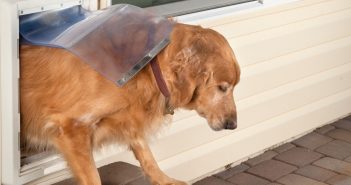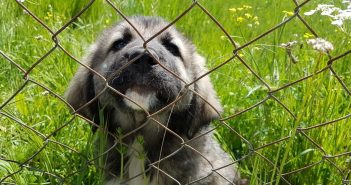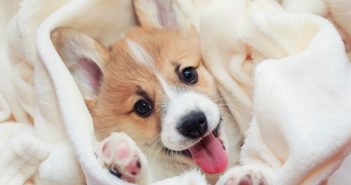Tips For Photographing Your Pet
by Ian White
If you have ever tried to take a picture of your dog, you will realize how hard it is to capture the pups full personality and beauty in a photograph. Dogs aren’t human, and they don’t understand what we are doing when we try to take their photo. They may think that the camera is a toy and charge at you, instead of striking a pose. If you follow these tips, and take your cues from your pet, you can be assured of great photos of your pet.
Pets come in all colors. If your dog is dark, you will need to make sure that he doesn’t get lost in your photo due to a dark background. Dark animals photograph best with light colored or neutral backgrounds. You can use white, grey, or creamy beige backdrops. You should never take a photo of a Black Lab, or a German Shepherd, against a dark background. It conceals the true color of your dog, and the dark background can also conceal the true size, shape and proportions of your pet.
The same rules apply with pets that have light coats. If you have an apricot or white puppy, you would not place her in front of a white wall for a picture. Photographs of animals need to capture the color and texture of their coats. If you have a white toy poodle, you would want to place her on, or in front of, a black, blue or brown backdrop. This will assure that the poodle’s springy white curls are the focus of the picture. It is important that you choose a background that compliments your dog, and doesn’t hide its beauty.
The hardest thing to do is to get your pet to sit still for a photo. The best time to arrange a photo session with your pet is when they are tired, or sleepy. One trick is to lay the correct color of sheet or blanket over your couch or chair. Allow your pet to lie there after he has had a good half hour of vigorous play. Once your dog appears to start dozing off, get its attention by a low whistle, a squeak from a squeaky toy, or the sight of a treat. The animal will perk up immediately and appear to be wide awake. It is important that you are ready to snap the shots immediately. For a larger dog you can drape its bed with the correct color of sheet or blanket. It is also best to take your pet’s picture when they are well fed. That way they are not distracted by wanting food while they are modelling for you. The treats you hold up will be more a curiosity item to them, instead of a hopeful dinner.
In professional animal pictures, usually the full body of the animal is shown. This allows the viewer to get a general idea of the size and proportions of the animal. It also will allow the viewer to get an idea of the animal’s general health and appearance. You wouldn’t want to have just a head shot of your pet if it had unique colorings that made it cute. Some animals appear to be wearing little white socks on their paws, or the ends of their tails may appear to have been dipped in a paint bucket. Be sure that your picture captures all of the unique things about your entire dog. However, if your dog just has an irresistible face, you can take head shots. Some pets will appear to smile when they are very happy. Nothing says “love me” like an innocent puppy face. You need to be conscious of the background. Even if the color is right, if it’s cluttered it will be distracting and take away from the pet. It is also important to make sure that your pet is in the center of the shot, and that it is not cropped off just before the tip of the ears, or tail.
When you are taking photos of your pets, it is important that you are at least at the animals eye level, or below. This gives the picture the sense of being from the dog’s viewpoint. You can accomplish this by elevating your dog to a higher position, like the staircase, or furniture. Or, you can lie on your stomach to achieve the same results. You need to zoom in as close as possible, while still capturing the entire body of your dog. You can edit out any red eye, later.
It is best to use a digital camera when you are photographing animals. With digital cameras you are not out any extra money for the photos that didn’t take because Spot looked away. With a digital camera you are free to take as many pictures of your animal as you like, so snap away. You can choose the best ones later, and delete the rest. You have more freedom with a digital camera. You are not constrained to just a set number of pictures, and you do not have to sit and wonder if they worked while they are getting developed.
If you plan to take pictures of your pet outside, it is best to do this early in the morning, or late in the evening. The natural lighting is better for photographs during these periods of the day. You still need to keep in mind the color choices of your background. You can take a picture of your black puppy sitting on a white patio, or in front of your home if you have light colored siding, or brick. You can take a picture of your white dog in a flower bed that has black mulch, or sitting in front of a dark brick wall. Most animals can obey the command of sitting. Some animals will even sit if they have a leash on, even if it is not being held. Outdoor, natural lighting works the best when you want to show the texture of your animal’s coat.
The expression of your dog is one of the most important things you need to keep in mind when you are photographing your animal. If your animal is ill, or having a bad day, you may want to reschedule your photo session to a later time. A wet and moist looking nose is a must in all pet photos. If your pet is feeling unwell, they probably aren’t up for their photo being taken. If your breed of pet should have perky ears, and they are laying down because the pet is not as cheery as usual, you should postpone your picture taking, as well. You should never take a picture of your pet if they have runny eyes due to an infection. Wait until your pet is doctored and feeling more like their cheery, upbeat self.
You can take action shots of your pet. Does your pet like to catch frisbee’s or herd sheep? To capture your pet in action you must learn what photographer’s term “panning.” The key to panning is to follow along with your pet as they are moving. You need to click away capturing them throughout their activity. You can choose a film that is made for action shots to get good results.
You know your pet and what excites them. Does your pet like to stand on two feet and beg for a certain toy, or treat? If so, then get someone to assist you during this photo. They can interact with the dog while you snap the pictures. These shots are great ways of showing the personality of your dog. Does your dog like to tilt its head when it hears a certain noise? Then be ready to capture their photo while your assistant provides the noise. Does your dog like to hide in the shrubs, or get playful with a ball? You can also capture these types of photos if you are tuned in and ready with your camera.
Photographs are a great way of preserving the beauty and personality of an animal. Just keep in mind background color, and try to photograph your pet for still shots when they are well fed and somewhat sleepy. If you photograph outside, try to arrange your photo time in the morning or late evening hours, and don’t take their pictures directly facing the sun. Make sure your pet is feeling physically well so that their personality can be captured, and if you use a digital camera you won’t have to worry about wasting film. If you take action shots, practice the panning technique. If your pet performs tricks, enlist the aid of a helper and photograph your animal performing. Photographs will be around forever, and if you do them correctly they can reveal a lot about your pet. Take your cues from your animal and you will have wonderful photographs every time.

Ian White is the founder of Pet-Sitters.biz, specializing in helping pet sitters and pet owners connect to each other. Your pet will miss you, but their environment remains intact. Find and screen a sitter for your pet or advertise your pet care business. Find a home visit Pet Sitting service.



